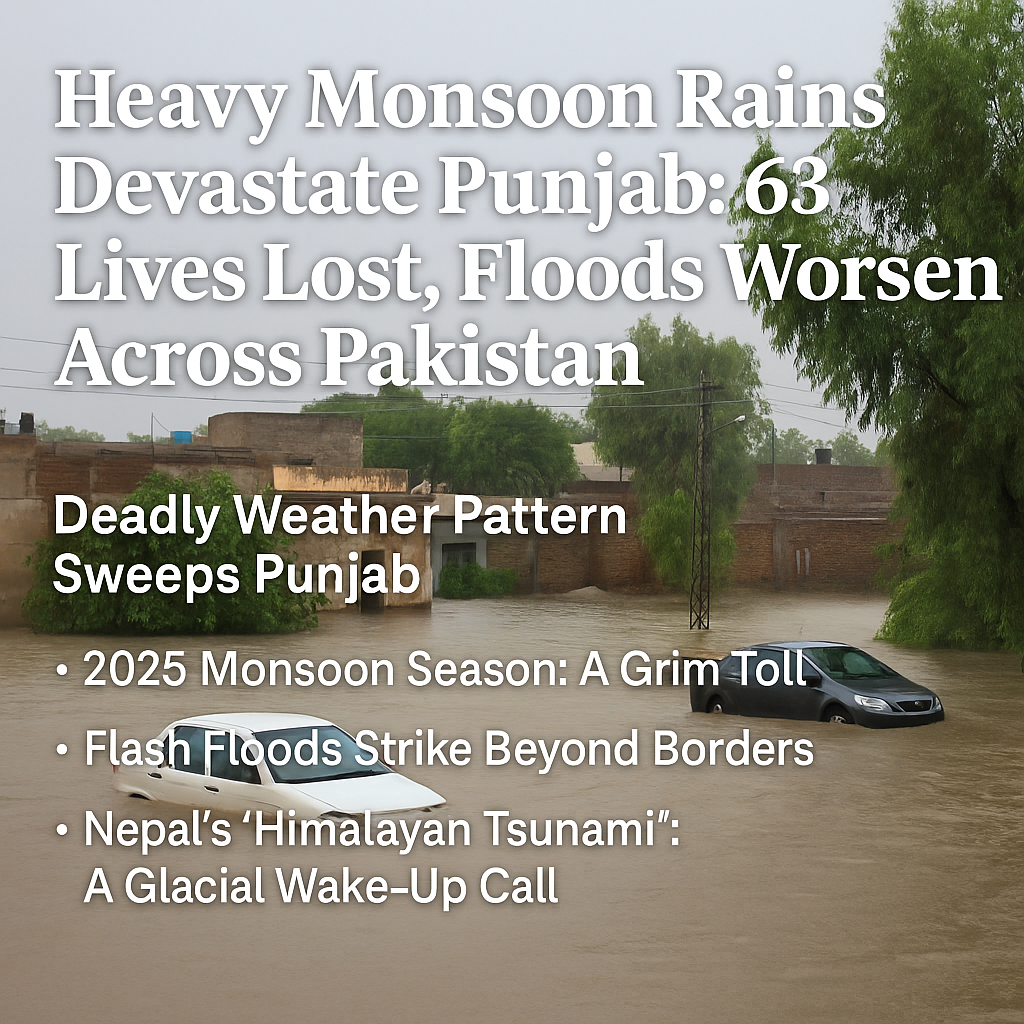Date Published: July 18, 2025
Overview
Torrential monsoon rains have caused widespread devastation across Punjab, Pakistan, resulting in at least 63 fatalities and displacing hundreds of families. As rivers breached their banks, flooding submerged homes, roads, and entire communities, highlighting once again Pakistan’s vulnerability to extreme weather events fueled by climate change.
Deadly Weather Pattern Sweeps Punjab
The relentless rainfall, which originated as thunderstorms in northwestern India, intensified into a powerful low-pressure system. By Tuesday night, it had entered Pakistan and unleashed havoc across several key cities, including Lahore, Islamabad, and Chakwal — the latter recording a staggering 423mm of rainfall, more than twice the monthly average for July.
Low-lying regions suffered the worst, with floodwaters rising rapidly. The majority of casualties occurred due to building collapses, electrocution incidents, and drowning. Emergency teams are still working to reach affected areas, many of which remain inaccessible due to waterlogged roads.
2025 Monsoon Season: A Grim Toll
This year’s monsoon season, which began in late June, has already claimed nearly 180 lives across Pakistan. Disturbingly, over half of the deceased are children, underscoring the heightened risk to vulnerable populations. Experts warn that the frequency and severity of such floods are increasing, linked directly to climate change and poor urban planning in flood-prone areas.
Flash Floods Strike Beyond Borders
Pakistan isn’t the only country facing climate-driven disasters. In the United States, flash floods wreaked havoc in New Jersey and New York this week. New Jersey declared a state of emergency after receiving more than 150mm of rain within hours. Tragically, two people lost their lives when their vehicle was swept away. Meanwhile, New York experienced its second-highest hourly rainfall on record, overwhelming subways and city streets.
Nepal’s ‘Himalayan Tsunami’: A Glacial Wake-Up Call
In Nepal, a different but equally alarming form of flooding emerged — a glacial lake outburst. A glacier near the Tibetan border melted rapidly this spring, forming a massive lake measuring 638,000 square meters. On July 8, the glacier’s structure gave way, releasing torrents of water downstream into Nepal’s Rasuwa district, killing at least seven people and destroying infrastructure.
This event is part of a growing trend in the Himalayan region, where rising temperatures are causing high-altitude glacial lakes to become unstable, threatening nearby communities with sudden flash floods.
Climate Emergency: A Regional Crisis
Pakistan’s geography makes it especially susceptible to flooding. With vast flatlands and limited flood management systems, even moderate rainfall can cause catastrophic damage. As climate change accelerates, experts urge urgent investments in flood defense infrastructure, early warning systems, and disaster preparedness.
Table: Key Weather Impacts in July 2025 (So Far)
| Location | Rainfall Recorded | Fatalities | Main Cause |
| Chakwal, Pakistan | 423mm | 63 | Flooding, collapses, shock |
| New Jersey, USA | 150mm+ | 2 | Flash floods |
| Nepal (Rasuwa) | N/A (glacial lake) | 7 | Glacial lake outburst |
Conclusion
The deadly monsoon in Punjab is a stark reminder of the changing climate’s real-world consequences. With rising global temperatures fueling more frequent and severe weather events, Pakistan must prepare for a future where such disasters could become the norm.
Keywords for SEO:
Pakistan monsoon 2025, Punjab floods, Chakwal rainfall record, climate change Pakistan, glacial lake outburst Nepal, New York flood, July 2025 extreme weather, Pakistan weather news, monsoon death toll, disaster preparedness Pakistan
